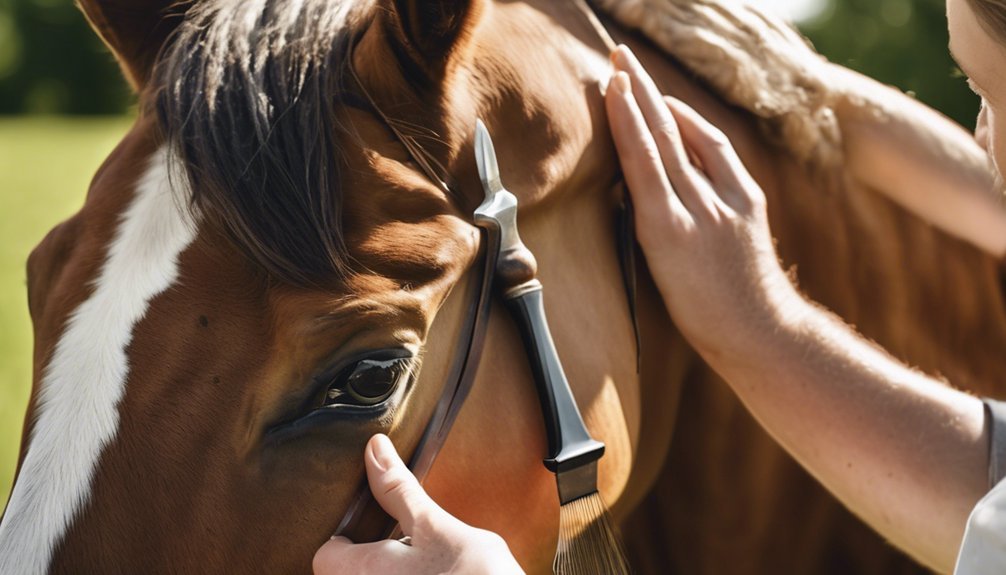
When it comes to preventing and treating horse mites, understanding their behavior and impact is crucial. These pests can cause discomfort and health issues if not managed properly. You'll need to recognize the signs of an infestation early and implement effective strategies to keep your horse safe. By focusing on prevention and treatment options, you can ensure a healthier environment for your horse, but the journey doesn't stop there. What else should you know?
Key Takeaways
- Regularly groom your horse, focusing on sensitive areas to spot early signs of mite infestations and maintain coat health.
- Keep the horse's living environment clean and dry by regularly cleaning stalls and changing bedding to reduce mite habitats.
- Use natural remedies like essential oils to deter mites, alongside regular grooming to prevent infestations.
- Consult a veterinarian for effective treatment options, including topical insecticides or systemic medications for severe cases.
- Ensure your horse has proper nutrition to support its immune system, helping to resist mite infestations.
Understanding Horse Mites and Their Impact

Horse mites, tiny arachnids that thrive in the environment of your equine companions, can have a significant impact on their health and well-being.
Understanding the mite life cycle is crucial in combating these pests. Mites typically undergo four stages: egg, larva, nymph, and adult, with each stage presenting opportunities for infestation.
Common types include the Chorioptes and Sarcoptes mites, which can cause skin irritations and discomfort. These mites often hide in bedding, stalls, and on your horse's skin, making prevention essential.
Signs and Symptoms of Mite Infestation
How can you tell if your horse is suffering from a mite infestation? Start by observing for signs like intense itching, hair loss, or redness in affected areas.
You might notice your horse rubbing against objects or frequently shifting positions, which are clear indicators of discomfort.
Another symptom to watch for is the presence of small scabs or lesions on the skin, particularly in sensitive areas.
Identifying infestations early is crucial, as untreated mites can lead to more severe skin issues.
Additionally, keep an eye out for behavioral changes; your horse may seem anxious or irritable.
Recognizing these signs promptly can help you take action before the problem escalates, ensuring your horse stays comfortable and healthy.
Effective Prevention Strategies

To effectively prevent mite infestations, regular grooming is essential, as it not only helps maintain your horse's coat but also allows you to spot any early signs of trouble.
Make it a routine to brush your horse thoroughly, focusing on sensitive areas like the mane, tail, and legs. Additionally, consider using natural remedies, such as essential oils, which can deter mites and promote a healthy coat.
Keeping your horse's living environment clean and dry is equally important; regularly clean stalls and bedding to minimize mite habitats.
Lastly, ensure proper nutrition to support your horse's immune system, making them less susceptible to infestations.
Treatment Options for Affected Horses
Despite your best efforts at prevention, mite infestations can still occur, necessitating prompt and effective treatment for affected horses.
Start by consulting your veterinarian to determine the best approach. Topical treatments, such as medicated shampoos or sprays, can directly target the mites and soothe irritated skin. These products often contain insecticides that eliminate parasites while providing relief from itching.
In more severe cases, systemic medications may be needed. These oral or injectable treatments work from within, effectively eradicating mites throughout your horse's body.
Always follow your vet's guidance on dosage and duration to ensure complete resolution of the infestation. By acting swiftly and utilizing the right treatments, you can help your horse regain comfort and health.
Maintaining a Healthy Environment for Your Horse

Maintaining a healthy environment for your horse is crucial not only for their overall well-being but also for preventing mite infestations.
Start with diligent stable hygiene; regularly clean and disinfect stalls to eliminate any potential mite habitats. Pay attention to bedding management, ensuring that you use clean, dry bedding to minimize moisture and dampness where mites thrive. Change bedding frequently and dispose of soiled materials properly.
Additionally, regularly groom your horse to keep their coat healthy and reduce the chance of mite accumulation. Providing a well-ventilated space will enhance air circulation and inhibit mite growth.
Frequently Asked Questions
Can Horse Mites Affect Other Animals or Humans?
Yes, horse mites can affect other animals and humans through mite transmission pathways. Understanding host species interactions is crucial to prevent cross-species infestations, ensuring both your horse and surrounding animals remain healthy and mite-free.
How Long Do Horse Mites Live Without a Host?
Imagine a ship adrift without a crew; horse mites can survive just a few days without a host. Their lifecycle heavily relies on host dependency, making quick intervention crucial for effective management.
Are Certain Horse Breeds More Susceptible to Mites?
Certain breeds might show varying characteristics influencing mite resistance. While some horses have thicker coats offering better protection, others may be more vulnerable. It's essential to assess each horse's traits when considering susceptibility to mites.
What Are the Long-Term Effects of Mite Infestations?
Mite infestations can lead to lasting long-term health issues, including chronic skin conditions and mite-related allergies. You might notice increased sensitivity and discomfort, affecting your horse's overall well-being and performance if left untreated.
Can I Use Natural Remedies to Treat Horse Mites?
Yes, you can use natural remedies like essential oils and herbal treatments to treat horse mites. These options can be effective, but you should consult a veterinarian to ensure safety and proper usage for your horse's health.
Conclusion
In the garden of your horse's health, every action you take is a nurturing drop of rain. By maintaining a clean environment and grooming diligently, you cultivate resilience against the invasive weeds of mites. When the storm of infestation arises, swift treatment is your shield, guiding your horse back to vibrant well-being. Remember, a strong immune system is the sun that helps your horse thrive, illuminating the path to a life free from the shadows of mites.





